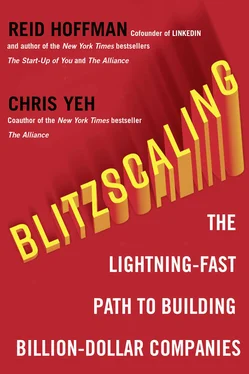“The Samwers gave us a gift,” Brian admitted many years later in our Blitzscaling class. “They forced us to scale faster than we ever would have.” By choosing to grow at a breakneck pace, Airbnb had achieved a dominant position in its market. Despite the initial advantages that the Berlin-based Wimdu had in human resources, financial capital, and European market knowledge, the techniques that Brian and his cofounders implemented allowed Airbnb to meet and ultimately defeat its challenger.
2010: SHENZHEN, CHINA, TENCENT HEADQUARTERS
About a year before Airbnb embarked on its blitzscaling journey, in a different CEO’s office on the other side of the world, the message that would change everything arrived in the middle of the night.
It was the fall of 2010, and Pony Ma (Chinese name: Ma Huateng) was trying to figure out what came next for Tencent, the company he had run since founding it in 1998 with four classmates from Shenzhen University. Thanks to its core product, the QQ instant messaging service, which had 650 million monthly active users, Tencent had become one of China’s most valuable Internet companies with revenues of nearly $2 billion, a market capitalization of over $33 billion, and more than ten thousand employees. However, QQ was now a mature desktop product based on late-1990s technology, and its user base had stopped growing. Its American counterpart, AOL Instant Messenger, was already in a swift decline.
Ma was convinced that Tencent had to develop a new breakthrough product for the emerging smartphone platform—or else. “Internet companies that can react will survive,” he said, “and those who can’t will die.”
The message Pony Ma read that night was from one of Tencent’s employees, Allen Zhang (Chinese name: Zhang Xiaolong), a fellow entrepreneur whose company, Foxmail, Tencent had acquired five years earlier. Zhang now ran the company’s Guangzhou R&D division, which was a two-hour drive from Tencent’s Shenzhen headquarters. He had been monitoring the rapid growth of a new social messaging product called Kik, which was especially popular among young people. He decided that Tencent needed to create its own social messenger for smartphones—and quickly.
Zhang’s proposal represented not only a huge opportunity but also a huge risk, with equally huge uncertainty about the outcome. While a new messenger service might appeal to young consumers, it was probably going to cannibalize QQ, which was, after all, Tencent’s core business. Furthermore, Tencent had partnered with leading mobile carriers like China Mobile to receive 40 percent of the SMS charges that QQ users racked up when they sent messages to mobile phones. A new service could hurt Tencent’s financial bottom line and at the same time risk its relationships with some of China’s most powerful companies.
It was the sort of decision that publicly traded, ten-thousand-person companies typically refer to a committee for further study. But Ma wasn’t a typical corporate executive. That very night, he gave Zhang the go-ahead to pursue the idea. Zhang put together a ten-person team, including seven engineers, to build and launch the new product.
In just two months, Zhang’s small team had built a mobile-first social messaging network with a clean, minimalistic design that was the polar opposite of QQ. Ma named the service Weixin, which means “micromessage” in Mandarin. Outside of China, the service became known as WeChat.
What came next was staggering. Just sixteen months after Zhang’s fateful late-night message to Ma, WeChat celebrated its one hundred millionth user. Six months after that, it had grown to two hundred million users. Four months after that, it had grown to three hundred million users.
Pony Ma’s late-night bet paid off handsomely. Tencent reported 2016 revenues of $22 billion, up 48 percent from the previous year, and up nearly 700 percent since 2010, the year before WeChat’s launch. By early 2018, Tencent reached a market capitalization of over $500 billion, making it one of the world’s most valuable companies, and WeChat was one of the most widely and intensively used services in the world.
Fast Company called WeChat “China’s app for everything,” and the Financial Times reported that more than half of its users spend over ninety minutes a day using the app. To put WeChat in an American context, it’s as if one single service combined the functions of Facebook, WhatsApp, Facebook Messenger, Venmo, Grubhub, Amazon, Uber, Apple Pay, Gmail, and even Slack into a single megaservice. You can use WeChat to do run-of-the-mill things like texting and calling people, participating in social media, and reading articles, but you can also book a taxi, buy movie tickets, make doctors’ appointments, send money to friends, play games, pay your rent, order dinner for the night, plus so much more. All from a single app on your smartphone.
Ma himself recognized the importance of the decision he had made, saying in an interview, “Looking back, those two months were a matter of life and death.”
These stories of extreme growth, whether in California or halfway around the world in China, are perfect examples of why it’s valuable to study what blitzscaling is and how it works.
Throughout this book, we will be telling the stories of various blitzscalers. Appendix B: The Blitzscalers includes brief profiles of these companies that provide more context. For even more background, visit Blitzscaling.com.
BLITZSCALING: THE SECRET WEAPON FOR BUILDING SCALE-UPS
When a start-up matures to the point where it has a killer product, a clear and sizable market, and a robust distribution channel, it has the opportunity to become a “scale-up,” which is a world-changing company that touches millions or even billions of lives. Often, the fastest and most direct path from start-up to scale-up is the hypergrowth produced by blitzscaling.
The enterprise software company Slack reached this critical stage once it was able to demonstrate the rapid and accelerating adoption of its team messaging apps by its initial market of software development teams. Nearly five years passed between the time when Slack was founded and the initial launch of its product. But once it launched, Slack users themselves drove user growth by adding many colleagues at a time, aided by a frictionless process that allowed new users to jump in with a simple Web application or by downloading a mobile app from iTunes or Google Play. After the company reached this point, it began to scale rapidly, adding employees, capital, and customers at a blistering pace. Slack had raised $17 million during the first five years of its life; within eight months of launch, it had raised another $163 million and a total of $800 million by late 2017.
Any company, whether a global giant or a start-up in a cofounder’s garage, would love to launch and grow killer businesses like Airbnb, WeChat, and Slack. Yet those who actually manage to do so, especially to the degree that Brian Chesky and Pony Ma did, are still exceedingly rare. Why is that? What sets these companies apart from the rest?
In this book, we will argue that the key to rapidly building massive businesses in today’s environment is the aggressive growth strategy of blitzscaling: a set of techniques that allows both start-ups and established companies to build dominant, world-leading businesses in record time.
ENTERING THE BLITZSCALING ERA
Over the past two decades, the Internet has completely reshaped both our daily lives and the world of business. Netscape’s blockbuster IPO on August 9, 1995, marked the beginning of both the dot-com boom and what I call the Networked Age. At the time, the rising stock prices of the dot-com boom attracted the most attention, but, in retrospect, the biggest change was that the Internet was beginning to connect all of us to people, information, resources, and other networks. There have been other revolutions in the past—steam, electricity, and radio spring to mind—but what makes the impact of the Internet so unique and so far-reaching is the fact it has made everything so much faster. Today, every individual can connect to any other individual immediately; that increased velocity is what makes blitzscaling possible and so powerful.
Читать дальше












